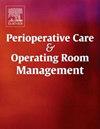Adductor canal block versus intra-articular analgesia for postoperative pain after arthroscopic anterior cruciate ligament reconstruction: A randomized trial
IF 1
Q2 Nursing
Perioperative Care and Operating Room Management
Pub Date : 2025-01-08
DOI:10.1016/j.pcorm.2025.100466
引用次数: 0
Abstract
Objectives
Optimal analgesia is crucial for promoting early rehabilitation and enhances functional recovery after arthroscopic anterior cruciate ligament reconstruction (ACLR). Our main objective was to compare the analgesic effectiveness of bupivacaine and dexamethasone administered in an adductor canal block (ACB) versus intra-articularly (IA) after ACLR. We hypothesized that the two approaches might have equal efficacy.
Methods
Seventy-two adult patients, ASA I–II, aged 18–65 years, undergoing elective ACLR under spinal anesthesia, were included in this randomized, double-blind, sham-controlled trial. Patients were randomly assigned to receive 18 ml of bupivacaine 0.25 % and 8 mg of dexamethasone either in ACB 30 min before spinal anesthesia or intra-articularly at the end of the surgery. Pain scores, both at rest and during movement, were assessed at 6, 12, 18, and 24 h after surgery. The time until the first analgesic request and the total analgesic consumption were recorded. Quadriceps muscle strength at 6 and 24 h after surgery, patient satisfaction, and any side effects were also recorded.
Results
The pain scores were significantly lower in the IA group at 12, 18, and 24 hrs after surgery, both at rest and during movement, with no patients requiring analgesia up to the first 17 hrs postoperatively. The times to the first ketorolac (1342.5 ± 132.7 versus 1167.5 ± 297.36 min, P= 0.029) and morphine (1412.5 ± 87.94 versus 1278.33 ± 274.04 min, P= 0.025) doses were significantly longer in the IA group compared to the ACB group. Kaplan-Meier curves for times to the first ketorolac and morphine doses showed significant differences (Breslow test) between the groups (P= 0.028 and P= 0.025, respectively). The total analgesic consumption was insignificantly lower in the IA group compared to the ACB group. Both groups had similar quadriceps muscle strength and patient satisfaction post-surgery, with no perioperative side effects observed.
Conclusions
The administration of bupivacaine plus dexamethasone for IA analgesia, compared to ACB, provided superior pain relief for up to 17 h following ACLR, both at rest and during movement.
内收管阻滞与关节内镇痛对关节镜前交叉韧带重建术后疼痛的影响:一项随机试验
目的关节镜下前交叉韧带重建术(ACLR)术后,最佳镇痛是促进患者早期康复和增强功能恢复的关键。我们的主要目的是比较布比卡因和地塞米松在ACLR后内收管阻滞(ACB)和关节内注射(IA)的镇痛效果。我们假设这两种方法可能具有相同的功效。方法随机、双盲、假对照试验纳入72例在脊髓麻醉下行选择性ACLR的成人患者,年龄18-65岁,ASA I-II级。患者被随机分配接受18毫升0.25%布比卡因和8毫克地塞米松,在脊髓麻醉前30分钟在ACB或在手术结束时关节内注射。在手术后6、12、18和24小时评估休息和运动时的疼痛评分。记录第一次使用镇痛药的时间和总镇痛药用量。记录术后6和24小时股四头肌肌力、患者满意度和任何副作用。结果IA组在术后12、18、24小时(休息和运动时)疼痛评分均明显降低,术后17小时前无患者需要镇痛。IA组到第一次给药酮洛酸(1342.5±132.7 vs 1167.5±297.36 min, P= 0.029)和吗啡(1412.5±87.94 vs 1278.33±274.04 min, P= 0.025)的时间明显长于ACB组。ketorolac和吗啡首次给药时间的Kaplan-Meier曲线(Breslow检验)组间差异有统计学意义(P= 0.028和P= 0.025)。与ACB组相比,IA组的总镇痛用量无显著性降低。两组术后四头肌肌力和患者满意度相似,无围手术期副作用。结论:与ACB相比,布比卡因加地塞米松用于IA镇痛,在ACLR后的17小时内,无论是在休息还是在运动中,都能提供更好的疼痛缓解。
本文章由计算机程序翻译,如有差异,请以英文原文为准。
求助全文
约1分钟内获得全文
求助全文
来源期刊

Perioperative Care and Operating Room Management
Nursing-Medical and Surgical Nursing
CiteScore
1.30
自引率
0.00%
发文量
52
审稿时长
56 days
期刊介绍:
The objective of this new online journal is to serve as a multidisciplinary, peer-reviewed source of information related to the administrative, economic, operational, safety, and quality aspects of the ambulatory and in-patient operating room and interventional procedural processes. The journal will provide high-quality information and research findings on operational and system-based approaches to ensure safe, coordinated, and high-value periprocedural care. With the current focus on value in health care it is essential that there is a venue for researchers to publish articles on quality improvement process initiatives, process flow modeling, information management, efficient design, cost improvement, use of novel technologies, and management.
 求助内容:
求助内容: 应助结果提醒方式:
应助结果提醒方式:


